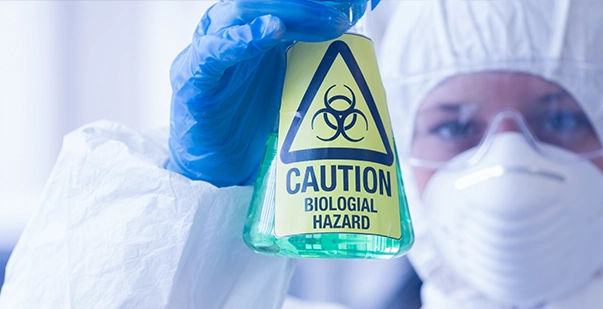Biological hazards are everywhere, even though we can’t always see them. Ever wondered how a simple cough can make an entire classroom sick? Or why do doctors wear masks and gloves when treating patients? That’s because they are protecting themselves from biological hazards roaming around in the form of microorganisms, such as bacteria, viruses, and fungi, that can make people sick.
These hazards aren’t just found in hospitals. They live in schools, workplaces, homes, and even in food. During the COVID-19 pandemic, the world saw just how dangerous a biological hazard can be. One tiny virus spread across the globe and changed daily life for billions.
So, what exactly are biological hazards, and how do they work? Are all germs dangerous? More importantly, how can we protect ourselves from them without living in fear? This article will break it all down with real-life examples and prevention tips you can actually use. Let’s get into it.
What Are Biological Hazards?
Biological hazards (also known as biohazards) are microorganisms or toxins produced by living organisms that can harm human health. These include bacteria, viruses, parasites, fungi, and biological toxins. Exposure to these agents can lead to infections, allergic reactions, or even serious diseases such as tuberculosis, HIV, or COVID-19.
They can spread through multiple routes, airborne particles, contaminated water or food, animal bites, insect vectors, or direct contact with infected individuals or surfaces. Hospitals, laboratories, farms, and waste management sites often carry a higher risk due to regular exposure to infectious materials. However, biohazards are not limited to specific places. Public transport, schools, and crowded events can also serve as hotspots for transmission.
One common concern is how you can protect yourself from biological hazards associated with human sources. Biohazards from human sources typically spread through blood, saliva, respiratory droplets, or other body fluids. Good hand hygiene, proper use of personal protective equipment (PPE), safe disposal of sharps and medical waste, infection control strategies, and routine cleaning of surfaces are key prevention methods.
What Are The Main Types of Biological Hazards?
Biological hazards can be grouped into several categories based on the type of harmful agent involved. Each type poses different health risks and spreads through specific routes like air, water, or contact. Here are some common types of biological contaminants with examples:
Read More: What is the OSHA Bloodborne Pathogens Standard?
1. Viruses
Viruses are microscopic pathogens that invade living cells to replicate. They rely on a host and cannot survive independently. Viral infections range from mild colds to life-threatening conditions. Transmission occurs through air, bodily fluids, or contaminated surfaces.
Common examples include Influenza (Flu), COVID-19, Hepatitis B and C, and HIV/AIDS, all of which vary in severity, transmission mode, and long-term impact on the immune or organ systems.
2. Bacteria
Bacteria are single-celled organisms. Some are beneficial (e.g., gut flora), but others are pathogenic. Harmful bacteria can cause infections in the lungs, skin, intestines, and bloodstream. They spread through air, food, water, or physical contact. That is why having proper training in infection control is important.
The most common bacterial hazards are Tuberculosis (TB), Salmonella, Staphylococcus (Staph), and E. coli. All of these are known for causing localized or systemic infections depending on the site and extent of exposure.
3. Fungi
Fungi are organisms that thrive in damp, warm environments. Some fungi infect the skin, nails, lungs, or bloodstream. Fungal infections are more dangerous in people with weakened immune systems or chronic illnesses. Conditions such as Ringworm, Athlete’s Foot, and Aspergillosis are commonly associated with fungal exposure, especially in poorly ventilated or moist areas.
4. Parasites
Parasites live in or on another organism (the host), feeding on its nutrients. They cause diseases that affect the skin, digestive system, or internal organs. Transmission often occurs through contaminated food, water, or insect bites. Diseases like Malaria, Tapeworm infections, Lice infestations, and Scabies are examples where parasitic organisms directly affect human health by draining resources or damaging tissue.
5. Biotoxins
Biotoxins are poisonous substances produced by living organisms, including bacteria, fungi, and certain plants and animals. They can be one of the major sources of biological hazards and cause serious health problems if ingested, inhaled, or absorbed through the skin. Some of the most common examples include Botulinum toxin, Mycotoxins, and Ricin. These are known for their high toxicity and potential for rapid health deterioration, even in small doses.
6. Allergens of Biological Origin
Some biological substances can trigger allergic reactions in people who are sensitive to them. These allergens do not cause infections but may lead to breathing problems, skin irritation, or severe allergic responses. Repeated or long-term exposure, especially indoors, can worsen symptoms and affect quality of life. Common biological allergens include mold spores, animal dander, dust mites, and pollen, which often originate from indoor environments, pets, or seasonal changes in vegetation.
Read More: How Long Does It Take to Become a Certified Caregiver?
Prevention of Biological Hazards
According to the World Health Organization, approximately 2 million workers die each year due to exposure to biohazards in the workplace. Preventing this reduces the risk of infections and diseases. It protects individuals, families, and communities. Proper prevention measures save lives, reduce healthcare costs, and promote overall well-being. Here are some of the steps that you should take for prevention:
Personal Hygiene
Good personal hygiene is the first step in preventing infections. Washing hands with soap and water removes germs. Hand sanitizers can be used when soap is not available.
Avoid touching the face, especially the eyes, nose, and mouth, as germs enter the body through these areas. Covering the mouth and nose while sneezing or coughing also helps stop the spread of infections.
Proper Food Handling
Safe food handling prevents biological hazards in food and foodborne illnesses. Cooking food thoroughly kills harmful bacteria and parasites. Storing food at the right temperature keeps it fresh and safe.
Fruits and vegetables should be washed before eating to remove dirt and pesticides. Eating raw or undercooked meat, eggs, and seafood increases the risk of infections, so they should always be properly cooked.
Vaccination
Vaccination protects against many infectious diseases. Vaccines help the immune system fight harmful viruses and bacteria. Common vaccines include those for flu, hepatitis, and COVID-19.
Children, adults, and the elderly should follow recommended immunization schedules. Vaccines are one of the most effective ways to prevent outbreaks and severe illnesses.
Workplace Safety
Some workplaces, such as hospitals and laboratories, have a higher risk of exposure to biological contaminants. Wearing protective gear like gloves, masks, and gowns helps prevent infections.
Employees should follow all safety protocols when handling medical or laboratory materials. Proper disposal of medical waste reduces the risk of contamination and disease spread.
Clean and Disinfect
Regular cleaning and disinfecting kill germs on surfaces. Frequently touched objects like door handles, phones, and keyboards should be cleaned daily.
Using disinfectants ensures that bacteria and viruses do not survive on surfaces. Keeping windows open or using air filters improves air circulation and reduces airborne infections.
Safe Water and Sanitation
Drinking clean water is essential for good health. Contaminated water can carry harmful bacteria and parasites. Boiling or purifying water makes it safe to drink.
Proper disposal of sewage and waste prevents the spread of diseases. Good sanitation practices help keep communities healthy and reduce the risk of infections.
Insect and Pest Control
Insects and pests can carry dangerous diseases. Mosquitoes spread malaria and dengue, while rodents can carry bacteria and viruses.
Using mosquito nets and repellents prevents bites. Keeping homes and workplaces clean reduces the chances of pest infestations. Stagnant water should be removed, as mosquitoes breed in standing water.
Proper Waste Management
Safe disposal of waste reduces the risk of infections. Biohazardous waste, such as medical and laboratory waste, should be placed in sealed containers.
Following waste disposal guidelines prevents contamination. Recycling and responsible waste disposal also protect the environment and public health.
Biological Hazards: Awareness and Prevention for a Healthier Life!
Biohazards, including viruses, bacteria, fungi, parasites, allergens, and biotoxins, can cause serious infections, chronic illnesses, or allergic reactions. These hazards spread through air, water, contaminated food, insect bites, or direct contact with infected individuals or surfaces. Simple actions like regular handwashing, using protective gear in high-risk settings, proper food handling, and maintaining clean environments can greatly reduce exposure. Similarly, timely vaccination also can prevent diseases caused by viruses and bacteria.
In workplaces, especially in healthcare and agriculture, infection control training can prepare the workers for associated emergencies. With awareness and consistent precautions, individuals and communities can protect themselves from the harmful effects of biohazards.
References:
https://www.comcare.gov.au/safe-healthy-work/prevent-harm/biological-hazards
https://safetyculture.com/topics/workplace-hazards/biological-hazard-examples/
https://www.sciencedirect.com/science/article/pii/S209379112300063X





